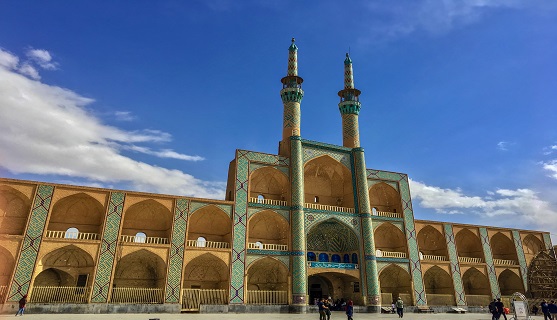Amir Chakhmaq is the name of a square in the historical city of Yazd, which includes a collection of different buildings such as a bazaar, a tekyeh, a mosque, two ab anbar (reservoir of drinking water) and a tomb. This astonishing square is one of the most important historical complexes in Yazd.
Amirchakhmaq square or Mirchakhmaq, as the residents of Yazd say, has been one of the main squares of the city in which people of Yazd gather for holding religious ceremonies or rituals during the history. That is why Amirchakhmaq Square is also known as the square of epic in Yaz.
Each of the buildings in this square has special features, therefore all of them are inscribed on the Iran National Heritage List:
Amir Chakhmagh Tekye in 1951
Amir Chakhmagh Mosque in 1935
Amir Chakhmagh complex in 1999
Ab Anbar in 2006
History of Amir Chakhmagh Complex
Amirchakhmaq square was built by Jalal ed-Din Amir Chakhmaq Shami in the ninth century AH, during the reign of the Timurids. He was one of the commanders of Shahrokh Teymouri and later became the ruler Yazd. Then with the help of his wife, Fatemeh Khatoon, he ordered to build a complex including tekye, a square, a public bathing, caravanserais, a khanqah, a qanat and a cold water well.
Safavid era
Amir Chakhmagh square was also known by the same name in the Safavid era. During the reign of Shah Abbas, some changes and restoration were made in the complex, the most important one was the construction of a charsoogh on the caravansary.
Qajar era
During the reign of Fath Ali Shah Qajar, Haji Hussein Attar added some parts to the shabestan of the mosque and also restored other parts of it.
Pahlavi era
Until the Pahlavi era, Amirchakhmaq, just like other squares, became a tomb for the dead bodies. During the Pahlavi era, this action was stopped from the beginning and after destroying the tombs, the square returned to its original state.
Different parts of the complex
Amirchakhmaq Mosque | The oldest building in the square
Amirchakhmaq Mosque, also known as the New Mosque or Duhok Mosque, is the oldest building of the Amirchakhmaq complex which is located on the southern side of the square. The construction of the mosque dates back to 841 AH and in terms of beauty, capacity, importance, and prestige among the other mosques of Yazd is standing in the second place (the first place goes to Jameh Mosque). This mosque has two shabestans; summer and winter shabestan. In its summer part and above the mihrab, there is a very beautiful windbreak, which is located on the southwest side of the mosque. The winter shabestan is located on both sides of the entrance hall and its light is provided by the light that comes through the marble.
Haji Ghanbar Bazaar
The oldest part of Yazd Bazaar is Haji Ghanbar Bazaar, which is located on the eastern side of Amirchakhmaq. This bazaar is one of the buildings built by Nizamuddin Haji Ghanbar Jahanshahi in the ninth century AH. In this bazaar you can find different unique Yazdi goods like delicious sweets, amazing local clothes, special carpets and gold.
Amir Chakhmagh Tekye
The middle part of the building, which is exactly above the entrance of Haji Ghanbar Bazaar, is higher than other arches and was decorated by glazed tile. Therefore, it can be concluded that this tekye was a place for famous people and governors of the city to gather there and watch the Ta’zieh ceremony.
There is an inscription in the shah neshin part (alcove) of the tekiyeh which shows the date of 1296 AH and this indicates that this part is 130 years old at least.
The historical Nakhl (palm) of Amirchakhmaq
The nakhl (palm) is a huge wooden coffin that is carried by the people in a ceremony called Nakhl Gardani (to move the palm) which is a symbol of Muharram mourning ceremony. The construction of the nakhl dates back to 450 years ago in the Safavid era. Amir Chakhmagh nakhl is decorated and made up of lattice work with porcelain knots and large beams, and its general shape reminds us of a cypress tree (symbol of freedom).
The tomb of Seti Fatemeh
Seti Fatemeh Khatoon was the wife of Amirchakhmaq, the founder square, who has made many efforts for the development of this area. She died in the ninth century AH and today her tomb is located in the northern part of the square. The building has a room with a dome decorated with green tiles. The interior of the building is made of plaster and mosaic tiles.
Amir Chakhmagh Ab Anbar
In Amir Chakhmaq historical complex, there are three Ab Anbar (reservoir of drinking water), one of which has been completely destroyed. The other ones are now considered as historical monuments.
There is a small reservoir in the Ab Anbar that has been turned into a museum. A museum in which you can see old objects related to water and people of the city.



Comment (0)